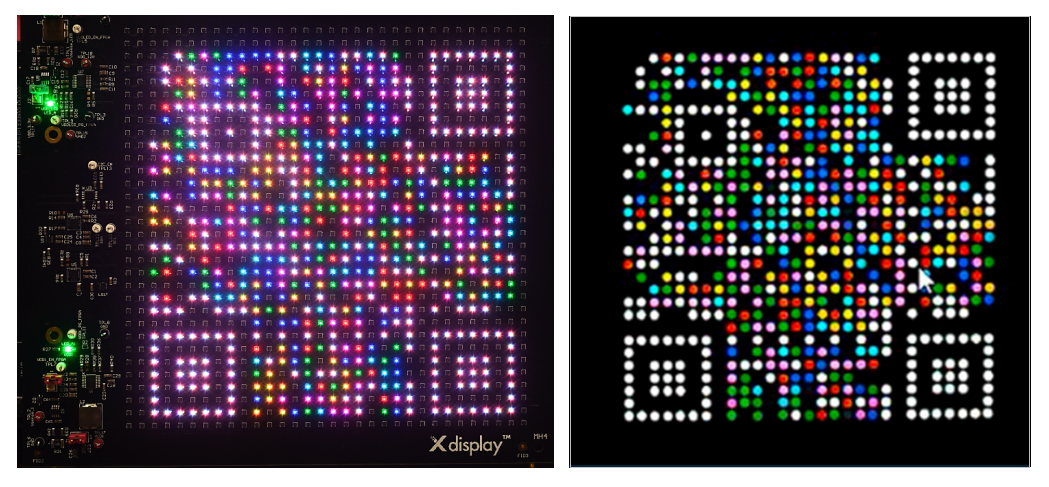New display hits 1 million FPS — display and high-speed camera could enable 1 Terabit per second communication speeds, beating current network interfaces
Not for humans, but for devices.

X Display Company (XDC) has introduced an advanced high-speed screen that can display one million frames per second. But while they use the term 'FPS' to describe the device, this unit is by no means designed for gaming, or rather, human beings. Instead, when paired with an ultra-fast camera, the display system is designed to enable low-power, high-bandwidth machine-to-machine communication at blindingly fast speeds.
The 'display system' (or rather a TX-RX system?) is comprised of an ultrafast microLED display that acts like a transmitter and a high-frame-rate camera that acts like a receiver. The display utilizes thousands of emitters operating across multiple wavelengths, flashing structured patterns of light at a rate of up to one million frames per second. Each frame contains a chunk of digitally encoded information, though XDC does not disclose how large that chunk is. A high-speed camera, positioned to face the display, captures these frames and decodes the data, enabling real-time, cable-free communication between the transmitter and receiver.
XDC suggests that continued development of the technology could lead to throughput at 1 Tb/s levels, which exceeds the performance of today's fastest network interfaces, but is still slower than the upcoming 1600G (1.6 Tbps) technology.

XDC says that the system dynamically adapts to bandwidth needs and achieves two- or three-times better energy efficiency than 800G optical transceivers. This is particularly valuable in data centers, where energy use for networking and cooling represents a significant share of operational costs. However, it is unclear how much power is required to decode and encode data transmitted in this manner.
Furthermore, XDC's interconnect architecture does not need physical fiber or copper connections, which could provide much-needed flexibility and ease of maintenance for massive data centers. In addition, XDC states that its system's performance can be dynamically adjusted in real-time in terms of data transmission paths and bandwidth allocations based on current needs, which could further simplify data center operations. However, a widespread change of medium from fiber or copper to air or vacuum might require a major redesign of servers and data centers, which is a hard endeavor for the industry.
"The capacity to dynamically transmit data at megahertz speeds through the air, holds transformative promise for cloud infrastructure," said Nikhil Jain, Director of OptoElectronics & Strategic Partnerships at X Display. "We are proud to present the world's fastest display and display-based optical links, enabling the transmission of vast data volumes through free space rather than cumbersome fiber bundles. Looking ahead, with continued innovation, terabit-per-second and beyond bandwidths are within reach — facilitating scalable, modular, and energy-efficient optical communication, and paving the way for pioneering applications such as optical computing."
Without any doubt, XDC's technology looks promising on paper. However, it remains to be seen whether it will find use beyond niche applications or use cases in actual data centers.
Get Tom's Hardware's best news and in-depth reviews, straight to your inbox.
Follow Tom's Hardware on Google News to get our up-to-date news, analysis, and reviews in your feeds. Make sure to click the Follow button.

Anton Shilov is a contributing writer at Tom’s Hardware. Over the past couple of decades, he has covered everything from CPUs and GPUs to supercomputers and from modern process technologies and latest fab tools to high-tech industry trends.
-
Hooda Thunkett To me, it looks like bandwidth is probably limited more by the resolution of the camera than anything else. Looking at that "QR code," I'd say you could easily double TX bandwidth by simply doubling the number of pixels in the display.Reply
Of course, I don't really understand the complexities involved, so that's easy for me to say. -
Neilbob I'm sure there are a few CS:GO players that would insist 1 million frames per second would be of vital importance to them.Reply -
helper800 Reply
And I am sure there are some folks who swear that anything above 24 fps is imperceptible to the human eye.Neilbob said:I'm sure there are a few CS:GO players that would insist 1 million frames per second would be of vital importance to them. -
Geef Replyhelper800 said:And I am sure there are some folks who swear that anything above 24 fps is imperceptible to the human eye.
Then the directors of The Hobbit released the movie at 48FPS and regular people saw what was possible. -
Nir___ Reply
If you watch LOTR trilogy (extended) at 24 FPS, you can fast forward it on this display and watch the entire thing in less than 1 second without skipping a single frame. This is not relevant for The Hobbit trilogy because you would like to skip as many frames as possible.Admin said:XDC has unveiled a microLED-based optical system that transmits data at one million frames per second through free space using a high-speed display and camera pair.
New display hits 1 million FPS, but it's not for gaming — display and high-speed camera could enable 1 Terabit per second communication speeds, bea... : Read more